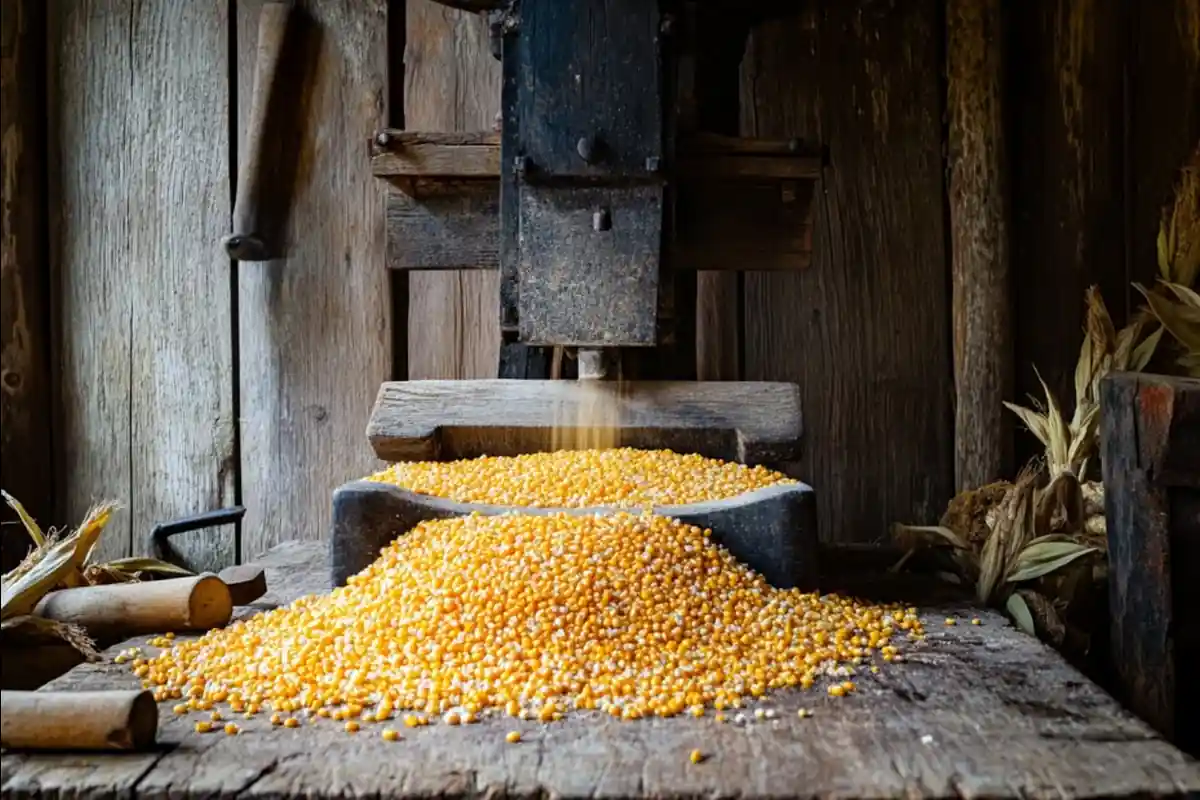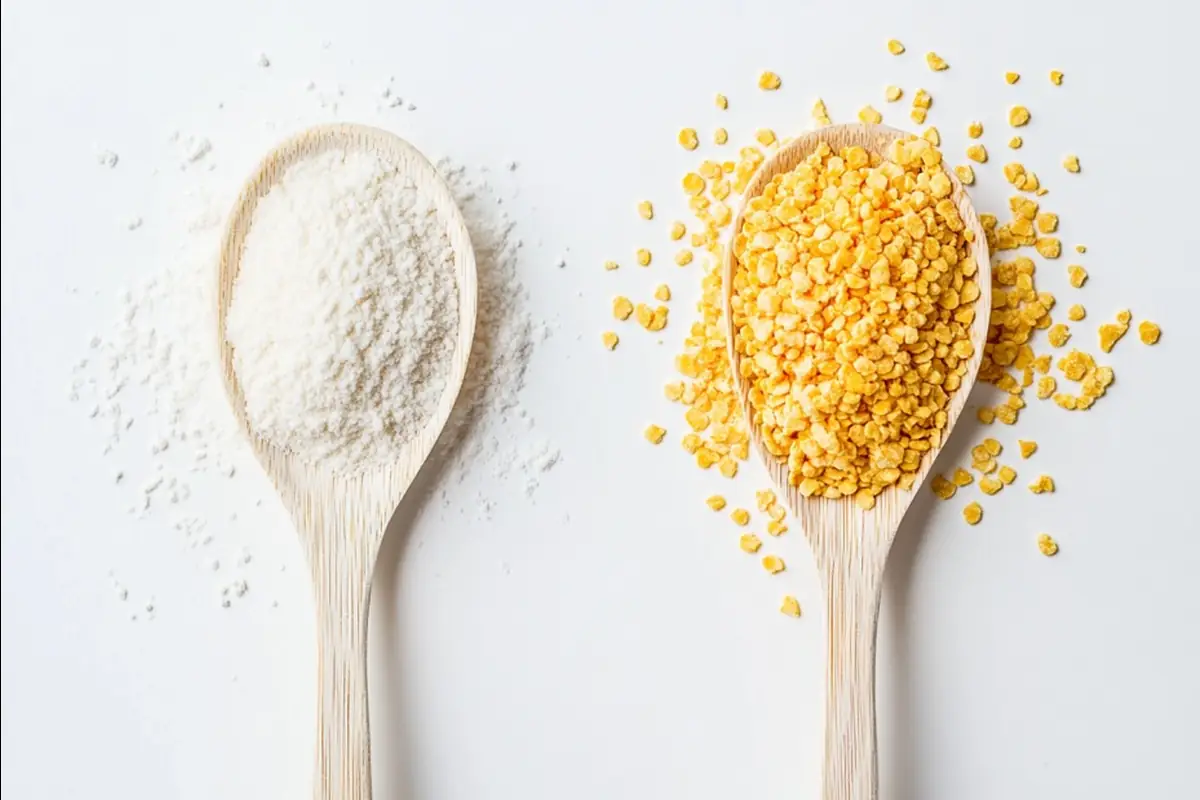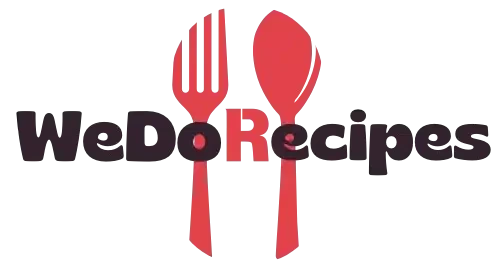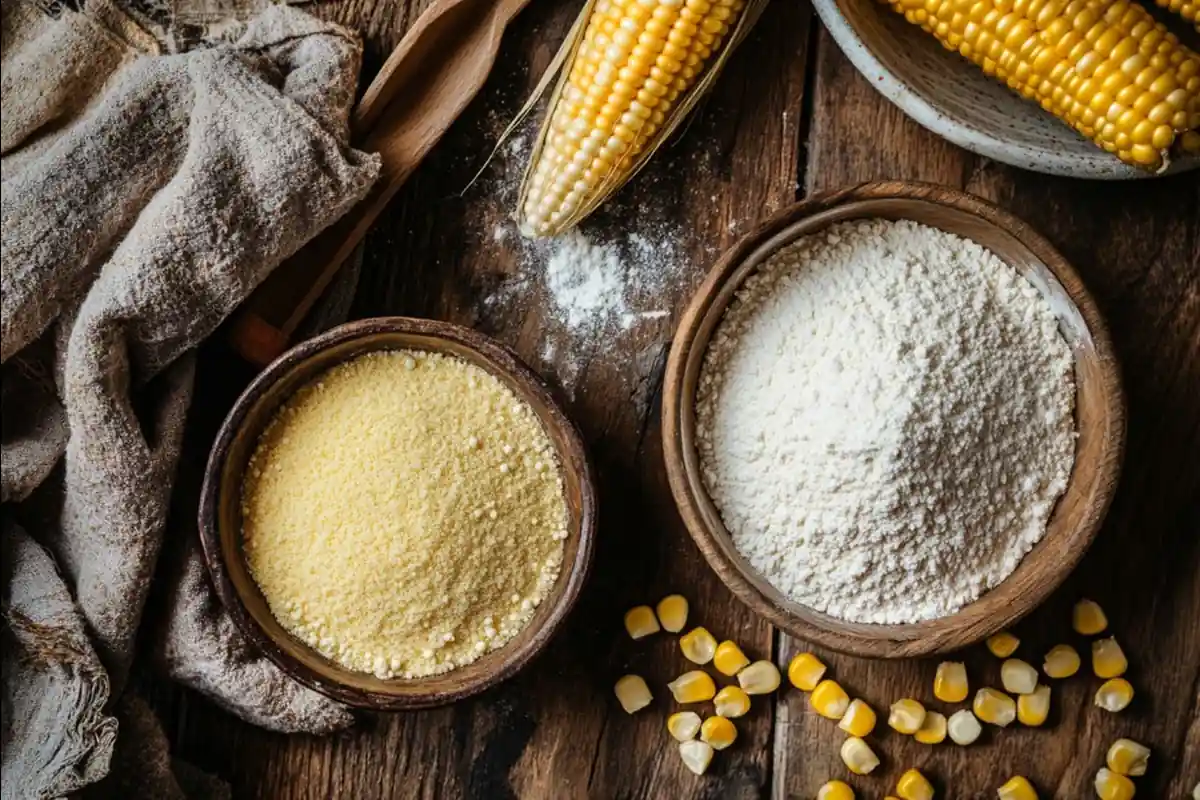I love cooking at home and often get confused about the difference between cornmeal and cornstarch. Both ingredients come from corn, but they serve distinct roles in cooking. Understanding the difference between cornmeal and cornstarch can help improve your recipes and enhance your cooking skills.
Overview of Cornmeal and Cornstarch
The difference between cornmeal and cornstarch lies in their texture, processing, and culinary applications. Cornmeal is a coarse flour made from dried yellow corn, giving dishes a grainy texture and a rich corn flavor. Cornstarch, on the other hand, is a fine, white powder extracted from the endosperm of corn kernels, primarily used as a thickening agent in sauces and soups.
Definition of Cornmeal
Cornmeal comes from grinding dried corn, usually dent corn. The grind can be fine or coarse, making it versatile for many recipes. Its starchy nature and flavor are perfect for dishes like cornbread and polenta.
Definition of Cornstarch
When comparing the difference between cornmeal and cornstarch, cornstarch stands out for its smooth texture and thickening properties. Extracted from the endosperm of corn, cornstarch is a flavorless, gluten-free powder used in gravies, sauces, and soups to enhance consistency. Unlike cornmeal, which retains the whole grain’s nutrients and fiber, cornstarch is purely carbohydrate-based.
| Characteristic | Cornmeal | Cornstarch |
|---|---|---|
| Appearance | Coarse, gritty texture | Fine, white powder |
| Flavor | Sweet, nutty | Flavorless |
| Gluten Content | Gluten-free | Gluten-free |
| Primary Function | Cooking and baking | Thickening agent |
Production Process of Cornmeal
To grasp the difference between cornmeal and cornstarch, it helps to understand their production processes. Cornmeal is made by grinding whole corn kernels, which retain their outer bran, inner germ, and starchy endosperm. This whole-grain approach preserves its fiber and nutrients, making cornmeal a healthier choice for cooking and baking.
Ingredients Used
Cornmeal comes from dried and ground whole corn kernels. It includes the outer bran, inner germ, and endosperm. This use of the whole kernel gives cornmeal its rich taste and good nutrition.
Grinding Techniques
- Stone Ground Cornmeal: This old method uses stone wheels to crush the corn. It keeps more germ and bran. This makes a coarser cornmeal with a stronger corn taste.
- Steel Roller Grinding: This newer method uses steel rollers to grind the corn. It removes germ and bran, making a finer, longer-lasting cornmeal with a milder taste.
Choosing between stone ground and steel roller grinding depends on texture, flavor, and shelf life. Producers must think about these to meet customer needs.
| Milling Technique | Texture | Flavor | Shelf Life |
|---|---|---|---|
| Stone Ground | Coarser | Richer, more pronounced corn flavor | Shorter |
| Steel Roller | Finer | Milder, more subtle corn flavor | Longer |
The cornmeal production process shows the effort put into making this corn product. Knowing about milling techniques helps consumers pick the right cornmeal for their cooking.
Production Process of Cornstarch
The difference between cornmeal and cornstarch also extends to their production methods. Unlike cornmeal, which includes all parts of the kernel, cornstarch is made solely from the endosperm. This results in a fine, flavorless starch used specifically for thickening soups, sauces, and desserts.

Ingredients Used
The main ingredient in cornstarch is the endosperm of the corn kernel. It’s mostly starch. The germ and bran are removed during making.
Extraction Methods
- First, the endosperm is separated from the germ and bran. This is done by soaking and grinding the corn kernels.
- Then, the ground corn goes through filters and centrifuges. This isolates the starch-rich endosperm.
- Finally, the endosperm is dried and ground into a fine powder. This is the final cornstarch product.
This careful process makes cornstarch a pure, refined starch. It’s great for thickening in cooking.
| Ingredient | Cornmeal | Cornstarch |
|---|---|---|
| Main Component | Entire corn kernel | Endosperm of corn kernel |
| Texture | Coarse to fine | Fine, powdery |
| Flavor | Slightly sweet, starchy | Neutral |
| Primary Use | Baking, coatings, thickening | Thickening agent in recipes |
The making of corn flour vs cornstarch shows their big differences. Cornstarch is a refined, special product. Cornmeal is more versatile.
Nutritional Differences Between Cornmeal and Cornstarch
A key difference between cornmeal and cornstarch is their nutritional value. While both come from corn, cornmeal contains fiber, protein, and essential nutrients, making it a more nutritious option. In contrast, cornstarch is primarily composed of carbohydrates, offering little to no protein or fiber. Specifically, cornmeal, which is made from the whole corn kernel, retains more of the grain’s natural nutritional value. As a result, it is rich in fiber, protein, and a variety of essential vitamins and minerals. Cornstarch, on the other hand, is mostly carbohydrates and has little nutritional value except for calories.

Macronutrients Comparison
Cornmeal has more dietary fiber than rice, offering 6 times more. It also has slightly more protein than rice, making it a better choice for health. Cornstarch, however, is mostly carbohydrates with very little fat and protein.
Micronutrient Breakdown
- Corn is richer in potassium, providing 6 times more than rice.
- Corn is 4 times higher in vitamin B2 compared to rice.
- Rice contains almost 2 times more vitamin B1 and 3 times more folate than corn.
The differences in micronutrient profiles show cornmeal’s better nutritional benefits. Its gluten-free nature also makes it a good choice for those on gluten-free diets.
Culinary Uses of Cornmeal
When discussing the difference between cornmeal and cornstarch, one major factor is how they are used in cooking. Cornmeal is a staple in many dishes, adding texture and a rich corn flavor. It is commonly found in recipes like cornbread, polenta, and coatings for fried foods, offering both structure and taste. For instance, it is widely enjoyed in recipes ranging from cornbread to polenta.
Common Dishes Featuring Cornmeal
- Cornbread: Cornmeal is key in cornbread, a favorite in the South. It’s great as a side or snack.
- Polenta: This dish from Northern Italy uses coarse cornmeal. It’s simmered until thick and creamy.
- Grits: In the South, grits are a savory porridge made from cornmeal.
- Coatings: Cornmeal is perfect for a crunchy coating on fried foods like fish, chicken, and veggies.
- Thickening: It thickens stews, chilis, and more. It adds texture and flavor.
Cooking Techniques
Cornmeal offers a variety of uses, depending on the recipe and the desired outcome. To illustrate, here are some common techniques:
- Baking: Cornmeal adds a corn flavor and coarse texture to baked goods like muffins, pancakes, and cookies.
- Frying: Its gritty texture makes it great for a crispy coating on fried foods.
- Boiling: Simmered in liquid, cornmeal turns into a creamy dish like polenta or grits.
The grind of cornmeal also matters. Finer grinds are good for baking. Coarser grinds are better for dishes like polenta and grits.
Culinary Uses of Cornstarch
The difference between cornmeal and cornstarch becomes even clearer when considering their culinary roles. Unlike cornmeal, which provides texture, cornstarch is primarily used as a thickening agent in sauces, soups, and puddings. Its fine, powdery consistency makes it ideal for creating smooth, velvety textures in various dishes. Its ability to make textures smooth and velvety is why it’s loved by both home cooks and chefs.
Common Dishes Featuring Cornstarch
- Egg drop soup: Cornstarch gives this Chinese dish its silky texture.
- Glazed pastries: Cornstarch makes glazes and icings shiny and glossy.
- Fried foods: A light dusting of cornstarch on chicken or vegetables makes them crispy.
- Gravy and sauces: Cornstarch thickens these to a smooth, lump-free consistency.
- Puddings and custards: Cornstarch thickens these desserts without needing lots of egg yolks.
Cooking Techniques with Cornstarch
To use cornstarch, mix it with cold liquid first. This prevents lumps. Then, heat the mixture to a boil to activate the thickening.
Unlike cornmeal, cornstarch is used in small amounts. It’s great for thickening without adding much. Learning to use cornstarch well can make your dishes better, from stews to desserts.
Texture and Flavor Profiles
In the diverse world of corn products, both cornmeal and cornstarch stand out for their unique characteristics and uses. Cornmeal, for instance, has a gritty texture that can range from fine to coarse. As a result, this distinctive texture makes cornbread crumbly and polenta grainy, adding to their appeal in different dishes. It also adds a corn flavor and a yellow color to dishes.
Cornstarch, on the other hand, is very fine and powdery. It has a neutral taste and turns silky when cooked. This makes it great for thickening sauces and gravies.
| Characteristic | Cornmeal | Cornstarch |
|---|---|---|
| Texture | Gritty, ranging from fine to coarse | Fine, powdery |
| Flavor | Distinct corn flavor | Neutral |
| Appearance | Yellow hue | Transparent when cooked |
| Culinary Applications | Cornbread, polenta, breading | Thickening sauces, gravies, custards |
The food textures and corn products comparison between cornmeal and cornstarch offer unique experiences. Each has its own benefits and uses in cooking.
How to Substitute Cornmeal and Cornstarch
Cooking and baking often require different ingredients for the best results. Cornmeal and cornstarch are not the same. But, there are good substitutes for each that work well in many recipes.
When to Use Cornmeal as a Substitute
Looking for a cornmeal substitute? You have a few options. These alternatives offer a similar texture and corn taste. Here are some common ones:
- Polenta: This is a coarser cornmeal. You can use it as a direct substitute for cornmeal, 1:1.
- Corn Grits: Corn grits are a bit coarser than cornmeal. Use 1/2 cup of corn grits for every 1 cup of cornmeal.
- Semolina: Made from durum wheat, semolina works as a substitute. Use 1 cup of cornmeal to 1 1/4 cups of semolina.
When swapping cornmeal, think about texture, taste, and how it absorbs liquid. This will help you get the right results in your recipe.
When to Use Cornstarch as a Substitute
Cornstarch is great for thickening. But, you can also use other ingredients for this purpose. Here are some good substitutes:
- Potato Starch: Potato starch is very similar to cornstarch. It’s a top choice for substituting, 1:1.
- Arrowroot Powder: This is a gluten-free option. It works well as a cornstarch substitute, 1:1.
- Tapioca Starch: Tapioca starch is another option. It might change the texture a bit. Use it 1:1.
When choosing a cornstarch substitute, think about the recipe and cooking method. Some substitutes work better in certain dishes.
Storage Considerations
Proper storage is crucial, especially when it comes to keeping corn products like cornmeal and cornstarch fresh. By taking the time to store them correctly, you can ensure they remain fresh and effective in your cooking. In addition, understanding the right storage methods helps preserve their quality and functionality for longer periods.
Storing Cornmeal
Cornmeal has a shorter shelf life because of its oil content. It can last up to a year if stored in a cool, dry place. To keep it even longer, refrigerate or freeze it. This stops rancidity and keeps the flavor and texture good.
Storing Cornstarch
Cornstarch, being pure starch, can last forever if stored right. Keep it in an airtight container in a cool, dry spot. This prevents moisture from causing clumps and losing its cooking power.
| Product | Shelf Life (Ideal Storage) | Shelf Life (Refrigerated/Frozen) |
|---|---|---|
| Cornmeal | Up to 1 year | Longer shelf life |
| Cornstarch | Indefinite | N/A |
Knowing how to store cornmeal and cornstarch helps them stay good for cooking. Proper food storage is vital for the shelf life of corn products.
Health Benefits of Cornmeal
Cornmeal, especially the whole grain kind, is packed with health perks. It’s a great source of dietary fiber, helping with digestion and keeping you full. It also has important minerals like iron, magnesium, and phosphorus, which are vital for our bodies.
Cornmeal is also rich in B vitamins and antioxidants. These add to its nutritional value. Since it’s a whole grain, it keeps more of its nutrients than refined grains. This can help with heart health and blood sugar control when eaten right.
Fiber Content
Cornmeal truly shines with its impressive fiber content. In fact, a 100-gram serving contains about 7-8 grams of fiber, which is quite significant for a single food source. This high fiber content not only makes it a top choice among fiber-rich foods but also brings numerous health benefits. For instance, fiber aids digestion, promotes satiety, and may even contribute to reducing the risk of colorectal cancer.
Potential Nutritional Advantages
- Cornmeal is packed with complex carbohydrates, which means it provides long-lasting energy. As a result, it’s an excellent choice for athletes or anyone who needs sustained energy throughout the day.
- It also has essential fatty acids and phytosterols to help control cholesterol. This is good for your cardiovascular health.
- The antioxidants in cornmeal, like carotenoids, fight oxidative stress. They help keep you healthy overall.
By incorporating whole grain cornmeal into your meals, you can unlock numerous benefits. Not only is it a nutritious choice, but it also enhances your dishes by adding both flavor and health.
Health Benefits of Cornstarch
Cornstarch may not be as nutritious as other foods, but it has its uses. It’s a low-calorie thickener, perfect for calorie-controlled diets. It’s also gluten-free, which is great for people with celiac disease or gluten sensitivity.
Low-Calorie Option
Cornstarch contains only 28 calories per tablespoon, making it an excellent option for those carefully monitoring their calorie intake. Moreover, it thickens sauces and gravies effectively without significantly increasing the calorie content. Additionally, its smooth texture makes it an ideal choice for calorie-conscious cooking.
Contribution to Gluten-Free Diets
Cornstarch is gluten-free, which is a big plus. It helps make gluten-free versions of many dishes and baked goods. This is especially helpful for those with dietary restrictions, ensuring a varied and satisfying diet.
But, cornstarch has a high glycemic index. So, it’s best to use it in moderation, especially for those with blood sugar concerns. Always think about the nutritional impact when adding cornstarch to your meals.
FAQ
What is the difference between cornmeal and cornstarch?
Cornmeal and cornstarch come from corn but are different. Cornmeal uses the whole kernel for a coarse texture and corn taste. Cornstarch, on the other hand, is just the endosperm, making it fine and tasteless.
What is cornmeal?
Cornmeal is a coarse flour from ground yellow corn. It has a high starch content and a corny texture. It can be fine or coarse, depending on how it’s ground.
What is cornstarch?
Cornstarch is a white powder from the corn kernel’s endosperm. It’s used to thicken dishes.
How is cornmeal produced?
Making cornmeal involves drying and grinding whole corn kernels. Stone grinding keeps more of the germ and bran, giving it a coarser texture and richer flavor. Steel rollers make a finer product by removing the germ and bran.
How is cornstarch produced?
Cornstarch focuses on the endosperm of the corn kernel. It’s separated from the germ and bran, then ground into a fine powder.
What are the nutritional differences between cornmeal and cornstarch?
Cornmeal is more nutritious because it uses the whole kernel. It has fiber, protein, and vitamins and minerals. Cornstarch, mainly carbs, has little nutritional value.
Final Thoughts on Cornmeal vs. Cornstarch
Choosing between cornmeal and cornstarch ultimately depends on your recipe and the specific results you want to achieve. On one hand, cornmeal adds not only texture but also a rich flavor and valuable nutrition to dishes, making it a versatile ingredient for various culinary creations. On the other hand, cornstarch is perfect for thickening sauces and making fried foods crispy.
Choosing the Right Product for Your Needs
Knowing what each ingredient does helps you cook better. Cornmeal is great for cornbread, fried fish, and tortillas because of its coarse texture and corn taste. Cornstarch, with its neutral flavor, is excellent for thickening sauces and soups without changing their taste.


2 thoughts on “What’s the difference between cornmeal and cornstarch?”